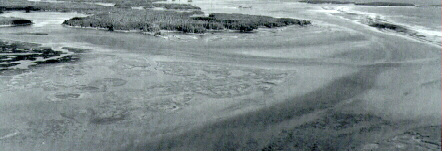
by: Glen Parsons
SUMMER/FALL 2002
Date of Post: July 2003
What is EHJV?
In 1986, Nova Scotia was one of the first Canadian signatories to North America's largest wetland conservation partnership - the North American Waterfowl Management Plan (NAWMP). This partnership of Canada, the United States, and Mexico sets out a blueprint for developing public-private partnerships to conserve wetland resources in North America.The Eastern Habitat Joint Venture (EHJV) is one of 15 regionally focused NAWMP partnerships. The EHJV covers Atlantic Canada plus Quebec and Ontario, and contains about 10 percent of the worlds wetlands. Primary Partners in Nova Scotia include DNR, Environment Canada - Canadian Wildlife Service, Ducks Unlimited Canada, the Nature Conservancy of Canada, and Wildlife Habitat Canada. Other supporters include corporate and private landowners, government agencies, conservation organizations and individuals.
In Nova Scotia, the EHJV secures, conserves, manages, and supports sustainable use of wetlands and associated uplands that benefit wildlife and their habitats.
For more information contact Glen Parsons (Kentville) 679-6223 or parsongj@gov.ns.ca
Protecting the Water Edge: Riparian Fencing Stewardship Project
Riparian zones are the transition areas that border the edge of lakes, rivers, streams, ponds, wetlands and coastal waters. They are an integral part of healthy wetlands, and the vegetation found there provides year-round habitat for many species of Nova Scotia wildlife. Large trees, shrubs and overhanging vegetation provide shade that cool waters and provides shelter critical for fish and other aquatic organisms. Riparian zones also provide nesting sites and protective cover for birds such as the American black duck and green-winged teal. Larger animals, including white-tailed deer and moose, use these areas for feeding and shelter, while aquatic fur animals such as muskrat and beavers establish denning sites along their banks. Riparian zones are often a continuous feature of the landscape, connecting different habitat types and providing natural wildlife travel corridors. Several species-at-risk and rare species, including the wood turtle and blue cohosh plant, depend on undisturbed riparian habitat. In addition to providing habitat for animals and plants, riparian zones also help protect water quality.  Riparian zones and associated wetlands located throughout Nova Scotia have been compromised by decades of agricultural practices such as uncontrolled livestock access. Since the mid 1700's, pastures have been located adjacent to water sources so livestock could access fresh water and the lush vegetation found there. Livestock can cause changes to riparian zones by affecting stream-side vegetation, stream morphology, channel substrate, precipitation runoff, sedimentation, water temperature, nutrient levels, water levels, stream flows, and stream bank erosion. Uncontrolled livestock access over time seriously degrades wildlife habitat and water quality.
Riparian zones and associated wetlands located throughout Nova Scotia have been compromised by decades of agricultural practices such as uncontrolled livestock access. Since the mid 1700's, pastures have been located adjacent to water sources so livestock could access fresh water and the lush vegetation found there. Livestock can cause changes to riparian zones by affecting stream-side vegetation, stream morphology, channel substrate, precipitation runoff, sedimentation, water temperature, nutrient levels, water levels, stream flows, and stream bank erosion. Uncontrolled livestock access over time seriously degrades wildlife habitat and water quality.
Today, many of the province's more than 1700 livestock producers are aware of the problem and wish to address it by establishing fencing and alternate watering systems on their farms. Since 1997, the Nova Scotia Eastern Habitat Joint Venture (NS-EHJV), in partnership with several other government and non-government associations and farmers, has been involved in a Riparian Fencing Stewardship Project to "fence out" or control livestock access to riparian zones, wetlands and waterways. To date, 60 projects have been completed that protect water quality and enhance over 688 hectares (1,700 acres) of valuable habitat located throughout Nova Scotia's ecologically rich agricultural landscape.
Conserving Coastal Habitats: Halifax Land Securement Project
The coastal area located to the northeast of Halifax is a picturesque landscape comprised of rolling hills and long shallow inlets with a mix of diverse habitats: salt marsh, eelgrass flats, saline ponds, sandy beaches, and small islands. This area hosts some of the highest densities of wintering Canada geese and American black ducks in eastern Canada. Additionally, the area is a major fall migration and staging area for thousands of waterfowl and other migratory birds. It is for this reason that the Musquodoboit Harbour Outer Estuary was designated a RAMSAR site in 1987. Ramsar is the popular name for the Convention on Wetlands of International Importance adopted in 1971 in the Iranian city of Ramsar. 
The uplands and wetlands of this region have long been recognized as an important area for wildlife and a priority securement area for the partners of the Nova Scotia Eastern Habitat Joint Venture (NS-EHJV). The NS-EHJV, in close partnership with the DNR Land Services Branch, has secured more than 1688 hectares (4170 acres) of valuable wildlife habitat through six land purchases (528 hectares/1304 acres), two private land donations (1125 hectares/2780 acres), and six land transfers (36 hectares/90 acres), since the signing of the North American Waterfowl Management Plan in 1986. The NS-EHJV partners continue to support and plan for the securement of other valuable habitats in the Halifax coastal area and throughout the rest of Nova Scotia.
